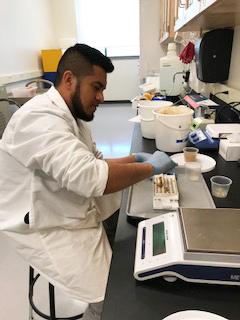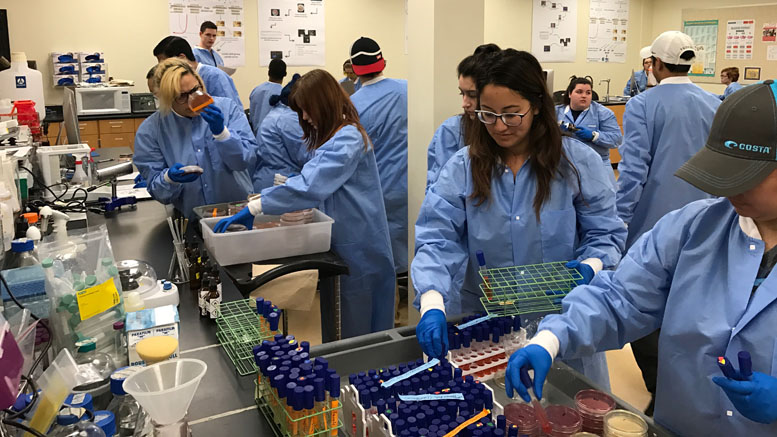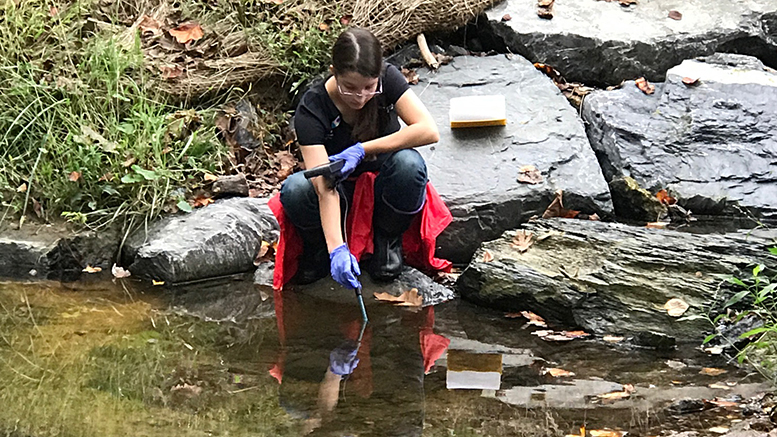After conducting field research on red-tailed hawks at Finger Lakes Community College (FLCC) in New York, Elizabeth Snyder continued that research at the Rochester Institute of Technology where she earned a doctorate and is now at Upstate Medical University studying microbiology and immunology.
Another former FLCC student, Alissa Carissimi, decided to pursue a career in science after studying stresses on coral reefs during a summer field research course in the Caribbean. She went on to earn a master’s degree in ecology at the University of Memphis and is now an adjunct professor at Union University.
Those are just two examples of how embedding research experiences into community college courses puts students on a track toward professional careers in science.
Before FLCC integrated research into its courses in 2006, only about 3 percent of students who went on to earn a bachelor’s degree at a four-year institution applied to graduate school to continue in a STEM field. By 2012, that number rose to 13 percent, says Professor James Hewlett, who also serves as executive director and principal investigator at the Community College Undergraduate Research Initiative (CCURI).
Insight on sponges
Hewlett’s biology students are currently using DNA sequencing to determine how many different types of freshwater sponges there are in rivers, streams and ponds in New England. It’s a collaborative project involving half a dozen colleges in the CCURI network that are studying sponges in other regions.
Students are collecting sponge samples, identifying the species, analyzing water quality and other factors, and trying to figure out why certain types of sponges are in some areas and not others. This hasn’t been done before, Hewlett says, so “they are generating a nice set of baseline data that would be useful for anyone studying biodiversity.”
Freshwater sponges are well-suited for community college research, he says.
“We spend a lot of time in CCURI trying to identify projects we know will work in the community college setting. Projects have to be engaging for students, long-term, accessible and can’t require a lot of expensive supplies or equipment,” he says.
CCURI recently received increased funding from the National Science Foundation (NSF), and now has 45 full partners who are eligible for financial support to develop a research program, and 35 network members who can attend CCURI conferences and get access to the group’s resources.
NSF is not likely to renew the grant when it expires in 2020, so Hewlett hopes a foundation might keep the program alive.
“There’s been so much momentum. The interest in research continues to grow,” he says.
Bears and honey
Meanwhile, CCURI is sponsoring and funding three network-wide collaborative research efforts, including one involving the use of field cameras for wildlife studies. Twenty-five people from CCURI colleges attended a workshop to learn how to use camera traps, which trigger a camera to start shooting when an animal walks by.
Some of the western colleges are using the technique to study mountain lion populations, while FLCC is tracking black bears. The bears don’t sleep all winter long, Hewlett’s students found.
“They come outside; they’re groggy but they’re more active than we thought,” he says.
The students also found the bears have as many as five cubs at a time, while it was previously thought they had just one or two.

A student at Bluegrass Community & Technical College works on a project to control mosquitoes, especially those carrying the Zika virus. (Photo: BCTC)
Biotechnology students at Bluegrass Community and Technical College (BCTC) in Kentucky are using a $100,000 DNA sequencer acquired by the college in 2015 through an NSF grant to analyze pollen in honey to determine its botanical origin. The project is a collaboration with the Kentucky Department of Agriculture. The research is important because new rules from the U.S. Food and Drug Administration require labels on honey to identify its source, says Deborah Davis, biotechnology program coordinator at BCTC. Honey must have at least 46 percent of its pollen from a single plant for it to be labeled as single-source honey, which makes it more valuable.
“We’re trying to work out a mechanism for other colleges around the country to do this,” Davis says. “When we get the method figured out, we’ll provide funding and scale up.”
Davis hopes to install some beehives at the campus garden this spring. Students will then learn about the bee lifecycle and how to extract honey.
“They will have ownership of the entire process,” she says. “Once a student can go out into the wild and start answering questions about the world around them, the more questions they will want to answer.”
BCTC students are also identifying the DNA sequences of certain plants where this hasn’t yet been done and are using bioinformatics to submit that information to a national database.
Previously, BCTC students worked on a NASA-funded project to determine the best way to grow plants in soil similar to that on Mars.
Of the 11 students in the program this semester, five already have bachelor’s degrees and came to BCTC for hands-on science experiences and to earn a post-bachelor certificate in biotechnology, which they need for certain jobs. Two of Davis’ former students have gone one to earn doctorate degrees, one in biomedical engineering and one in biology.
Winning competitions
After Del Mar College in Texas embedded research into courses in 2011, graduation and completion rates in the biotechnology program increased more than 50 percent, says biology professor John Hatherill.
Hatherill’s students not only conduct research, they’ve published their findings, given presentations at scientific meetings and won competitions – in many cases beating graduate students and postdocs from top universities. At one point, students from Del Mar swept the awards at an American Society of Microbiology conference.
Noting that his students get excited about learning when they see a virus for the first time in an electron micrograph, he says, “That’s something you can never get with a traditionally taught class.”
An ongoing project at Del Mar calls for students to collect soil from different areas in the community, isolate and analyze the viruses that infect bacteria in the soil, and test the bacteria for resistance to antibiotics.

Students conduct research in a science lab at Del Mar College in Texas. (Photo: DMC)
In 2017, that project netted Del Mar a first-place award in the Community College Innovation Challenge, a program sponsored by NSF and managed in partnership with the American Association of Community Colleges.
“There is growing evidence that you can use viruses to kill bacteria,” Hatherill says, and that’s important because “we don’t have any alternatives to antibiotics.”
One of his former students, John Ramirez, won a first-place prize in the cell and molecular biology category at an American Association for the Advancement of Science competition in Washington, D.C., in 2012. He subsequently earned a bachelor’s degree at Texas A&M and currently serves as Hatherill’s teaching assistant while applying for medical school.
In 2010, Del Mar student Jennifer Robles won first place for a life sciences project that included a $10,000 prize. Since then, she has earned a master’s degree and snared a professional science job in the private sector.
Hatherill secured grant money for travel and living expenses annually to send about three dozen students to a summer internship program at the Lawrence Berkeley National Laboratory in California. Two of his students were among 96 nationwide selected for a program at the Argonne National Laboratory in Chicago.
“A lot of our students come from humble background,” he says. “They are diamonds in the rough. Many are the first in their families to attend college and need proper mentoring.”
“Students have told me the program has changed their life and their whole career trajectory,” he continues. “Research is the only way to really engage students in something meaningful and give them skills that can get them jobs or into a graduate program.”
Research teams
In Maryland, Howard Community College began embedding research into STEM courses in 2015 to take advantage of a new building with a dedicated research lab, says Patricia Turner, dean of science, engineering and technology.
Students take four one-credit courses in sequence starting with a research boot camp where they learn about methodology, note keeping and ethics. Toward end of the semester, faculty pitch research topics, students pick their top three choices, and they’re assigned to a three- or four-member interdisciplinary team.
During the second semester, students read primary literature on their topic and begin collecting data. In the fall, they carry out experiments, and in the final semester they complete their projects and make presentations.

Howard Community College students give a presentation on “PSR1913+16: The Binary Pulsar – Mathematical Reproduction and Extension.” (Photo: HCC)
Projects have been in virtually every science and engineering discipline, Turner says. Students working on a theoretical physics project are using a double pendulum to model predictions about chaos, for example.
Another group is looking at how caterpillars develop feeding preferences and whether it’s possible to get them to eat something besides tomatoes, which would be a big benefit to agriculture.
Other teams are examining micro-nutrients in soil on campus; using HCC’s rooftop observatory to look for exo-planets outside the solar system; and exploring how variables such as speed and temperature affect the strength of a material used in 3D printing.
Higher retention rates
Because “students are sticking around to complete their projects,” the fall-to-fall retention rate for students in research teams is 81 percent, Turner says. That compares to an average of 52 percent overall among students in the science, engineering and technology division.
There was also an unexpected benefit, she says. As a result of faculty coming together to plan and mentor the research, they become “really engaged and excited about the projects.” And that has led to expanded collaboration with other entities. An advisory board was convened two years ago that includes representatives from universities, private companies, the National Institutes of Health, and the National Academy of Sciences. HCC’s university partners help articulate coursework and place students in their labs, government agencies provide speakers and arrange tours, and companies, such as W.R. Grace, assist with internships and job placement.
“We’re trying to make sure students have parallel experience to students in four-year schools,” Turner says. HCC students go to poster sessions at universities, and HCC is raising funds so students will be able to make presentations at conferences.
Last year, a group of faculty launched a “journal of research in progress,” Turner adds. Students who report on their research can now say, “I submitted a paper and had it reviewed and accepted.”

